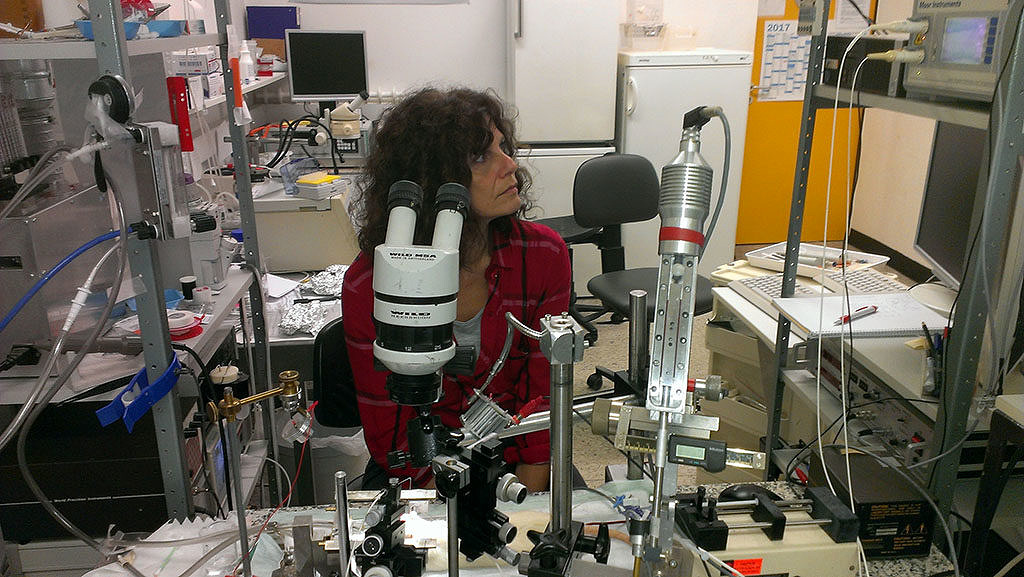New research cooperation investigates the causes of migraines

Alexander von Humboldt Foundation provides funding for institutional partnership
Headaches can be a real pain for sufferers. If they occur as migraines, patients suffer even more and have to deal with nausea and dizziness or become over-sensitive to light and noise. An institutional partnership was set up between FAU and the University of Szeged in Hungary in January 2018 to research the causes of headaches. The collaboration has received funding for three years from the Alexander von Humboldt Foundation. During this time, researchers at both universities will work together to investigate the pathophysiological causes of headaches and migraines. In an interview, Prof. Dr. Karl Meßlinger from the Institute of Physiology and Pathophysiology at FAU and Dr. Mária Dux from the Department of Physiology at the University of Szeged explain how the cooperation came into being and how the researchers are collaborating.
Prof. Meßlinger, how did the cooperation with the University of Szeged in Hungary come about?
Dr. Dux worked as a researcher in my working group at the Institute of Physiology and Pathophysiology from November 1999 to 2000 as part of her Humboldt scholarship. We have been cooperating almost continuously ever since on various research projects. She has also been a regular guest researcher at our institute for several weeks at a time over the last few years, also with the support of the Alexander von Humboldt Foundation. The new institutional partnership was set up at the beginning of this year and offers the ideal platform for supporting our work during the coming years.
Dr. Dux, what will your research be focusing on in this new institutional partnership?
During this cooperation, we will be researching various mechanisms that can play a role during the development of headaches, based mainly on animal experimentation. Above all, we would like to find out how the various inter-cranial nerve fibres communicate with each other and increase, for example, the risk of migraines during stressful situations.
How are your working groups collaborating?
Prof. Meßlinger: We usually carry out the experiments we’ve planned together in our institute in Erlangen. The Alexander von Humboldt Foundation provides the funding for the travel and living costs of the researchers as well as for smaller laboratory devices at the Department of Physiology in Szeged. Our young researchers can get to know the partner institute and the scientific work carried out there and receive support and advice during the joint research projects.
Dr. Dux: I spend about six to eight weeks a year in Erlangen. We complete most of the research work during this time. The results are analysed and publications are written both in Erlangen and Szeged. The funding has already enabled one young researcher from my institute to visit Dr. Meßlinger’s laboratory.

Prof. Meßlinger, how does FAU benefit from this collaboration with the University of Szeged in Hungary?
First of all, the benefits for FAU are financial due to the grant awarded by the Alexander von Humboldt Foundation. However, the sum is small, as the budget for the project is relatively low. The networking of science and teaching is a significantly greater advantage for both universities.
And which advantages does this cooperation with FAU offer you for your research, Dr. Dux?
My teaching duties at my home institute mean that I am heavily involved in the day-to-day activities of medical students at the university, which leaves me with little time to concentrate on research. I can devote more of my time to my experiments when I am in Erlangen, which enables me and my research group in Szeged to make progress in our scientific work.
Have you already achieved any results, Prof. Meßlinger?
We have already published a series of joint publications from our previous collaboration projects. These publications deal with the effects of chemical mediators of nerve fibres that play a role in the development of headaches. A new publication about the results of our work in the current partnership is being reviewed.
Dr. Dux, you spent some time at FAU with your Humboldt scholarship in 1999/2000. What areas were you researching and how did your stay at FAU help you to progress?
I first spent a longer period of time at FAU as a Humboldt scholarship holder in 1999. Even back then I worked in Prof. Meißlinger’s working group and investigated the effects of histamine on blood flow in the cerebral membrane. It was during this time that I first dealt with the issue of how headaches develop. I was instantly fascinated and it has remained a focus of my scientific work ever since.
Prof. Meßlinger, have you also been to Hungary as part of this new cooperation? If yes, what did you find particularly positive about your stay at the University of Szeged?
I have visited the University of Szeged twice, but before the institutional partnership began. I remember being struck by how flexible the collaboration at the partner institute was. During one of her visits to Erlangen, Dr. Dux held a lecture for our students in physiology, while I had the opportunity to give a lecture for German students in Szeged. The students in Szeged seem very open-minded and extremely interested in their subject. The scientific work carried out at the Department of Physiology in Szeged is up to date and one must give credit to our colleagues there for still taking the time to carry out research despite their heavy teaching workload.
And what did you enjoy about your time at FAU, Dr. Dux?
The atmosphere in Prof. Meßlinger’s lab has always been particularly pleasant. The scientists there are professional and helpful. I have always enjoyed working with them. And the interesting discussions with colleagues in the lab often give me ideas for new research projects.
Thank you for taking part in the interview.